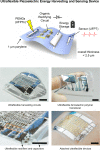Imperceptible energy harvesting device and biomedical sensor based on ultraflexible ferroelectric transducers and organic diodes
- PMID: 33893292
- PMCID: PMC8065095
- DOI: 10.1038/s41467-021-22663-6
Imperceptible energy harvesting device and biomedical sensor based on ultraflexible ferroelectric transducers and organic diodes
Abstract
Energy autonomy and conformability are essential elements in the next generation of wearable and flexible electronics for healthcare, robotics and cyber-physical systems. This study presents ferroelectric polymer transducers and organic diodes for imperceptible sensing and energy harvesting systems, which are integrated on ultrathin (1-µm) substrates, thus imparting them with excellent flexibility. Simulations show that the sensitivity of ultraflexible ferroelectric polymer transducers is strongly enhanced by using an ultrathin substrate, which allows the mounting on 3D-shaped objects and the stacking in multiple layers. Indeed, ultraflexible ferroelectric polymer transducers have improved sensitivity to strain and pressure, fast response and excellent mechanical stability, thus forming imperceptible wireless e-health patches for precise pulse and blood pressure monitoring. For harvesting biomechanical energy, the transducers are combined with rectifiers based on ultraflexible organic diodes thus comprising an imperceptible, 2.5-µm thin, energy harvesting device with an excellent peak power density of 3 mW·cm-3.
Conflict of interest statement
The authors declare no competing interests.
Figures







References
-
- Myny K. The development of flexible integrated circuits based on thin-film transistors. Nat. Electron. 2018;1:30–39. doi: 10.1038/s41928-017-0008-6. - DOI
-
- Matsui H, Takeda Y, Tokito S. Flexible and printed organic transistors: from materials to integrated circuits. Org. Electron. 2019;75:105432. doi: 10.1016/j.orgel.2019.105432. - DOI
-
- García Núñez C, Manjakkal L, Dahiya R. Energy autonomous electronic skin. npj Flex. Electron. 2019;3:1. doi: 10.1038/s41528-018-0045-x. - DOI
Publication types
MeSH terms
LinkOut - more resources
Full Text Sources
Other Literature Sources

